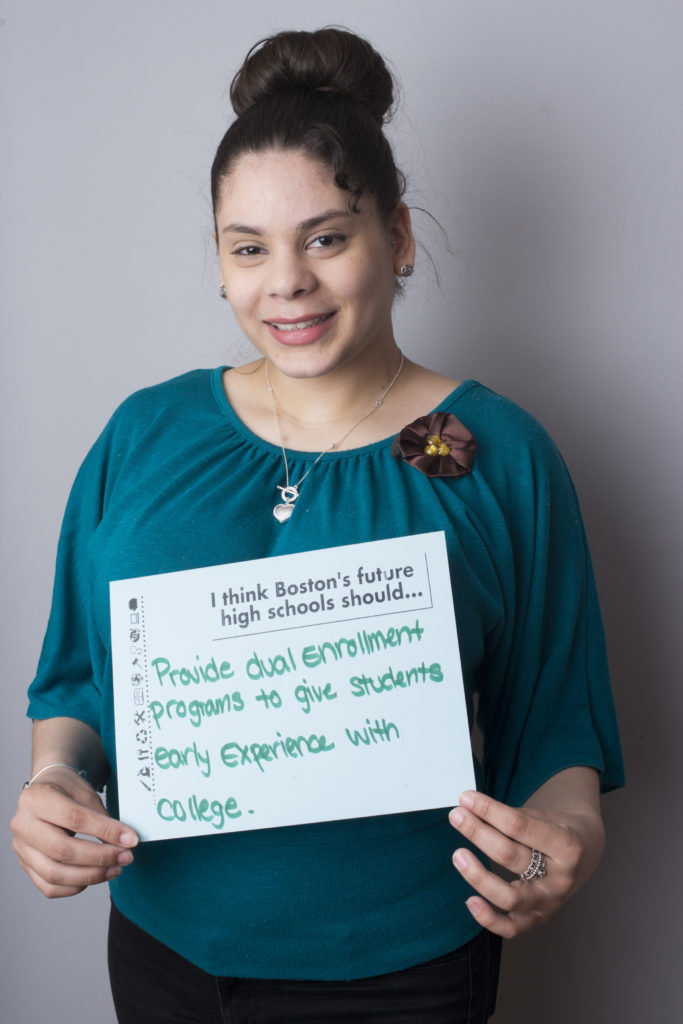
By Selinés Díaz
The Boston Public high schools should provide every student with an option to take college courses while in high school. This kind of program, known as dual enrollment, would allow students to explore their interests and gain experience and exposure to the expectations of college. They would be able to acquire the skills that are needed to succeed in college while still having the support of their families and their high schools.
I interviewed Kristin Russo, an English Teacher at Boston International High School who teaches a college level English class to her high school seniors.
Selinés: For my first question, how would you define “dual enrollment”?
Kristin: Dual enrollment is high students taking college-level courses. What I’ve learned is that sometimes they’re taking the college course in the high school, and other times they’re taking it on their own outside of a high school classroom. Dual enrollment allows students, while they’re in high school, to get college credit. The way I thought about it at the school I taught at, Boston International, was an opportunity for students to get exposure to what college classes would be like. They’re taking a college class, they have a college professor, but they also have the support of a high school teacher. This high school teacher complements and supplements the curriculum and teaches some of the skills that the high school students might not have, but that the college professor expects them to have. So it’s an opportunity for the student to get support with the work.
Selinés: What are the benefits of dual enrollment for students, schools, and teachers?
Kristin: For high school students, I think the benefit is that they get exposure to learning about the college curriculum and the college experience. They learn what college curriculums look like and how to read a syllabus. They learn certain student skills like time management. They learn about pace. In college, oftentimes college professors give you this syllabus, and they don’t necessarily remind you when things are [due]. They don’t necessarily give you scaffolds or support to get them done. I think that for high school students that are taking dual enrollment classes, another benefit is that they feel really empowered. They feel like they can do it, so I think they feel some confidence upon entering college when they decide to do that. They also feel more prepared so they’re less likely to drop out.
For me [as a teacher], the benefit was that I got to teach something new, which I was really excited about. I had never taught a college-level class before. Something I wish I would have benefited from, but didn’t, was that I really wanted to learn more about what college-level expectations were. I wish there had been more collaboration with the college professors.
I’ve been teaching for 14 years, but I’ve been teaching twelfth grade for 12 of those 14 years. So for 12 years I’ve been assuming that I’m preparing kids for college without actually knowing if I was preparing them for college. I really wanted to learn about that. What do freshmen-level essays look like, what does a reading calendar look like for them, how much reading should they be doing? I think more collaboration could be a great benefit for the high school teacher and the college professor. The high school teacher can learn what it’s like to teach college, and the college professor can learn where the high school students are coming from.
For the school, I think there is an opportunity for a beneficial partnership to develop between the high school and universities or colleges. My students took classes through Salem State University. There was a nice partnership that was formed between our school and Salem State. We got to go visit and sit in on a class. Also, when schools–like Boston International–describe ourselves to other schools or to potential students, we can say we offer college classes in our school, come try it out. I think it’s a way to “sell” the school.
Selinés: You were mentioning the positive things of dual enrollment, but what are some challenges that you might face as students, schools, or teachers involved in the program?
Kristin: My students would say one of the challenges is that college students have a very different schedule from high school students. They take probably four or five classes, and they go to class for a few hours a day. The rest of the day is their own. They can study or they can work if they need to. High school students are typically on the bus for school by seven in the morning, and school starts at eight. They’re in school until 2:30. If they leave right after school, they’re home by 3:30 or 4. Many students work after school. The dual enrollment schedule is really hard for high school students because in addition to having this college class, which requires a lot of reading and a lot of writing, they have other classes that they’re taking throughout the day. They just don’t have enough time to do all the work.
You must be logged in to post a comment.